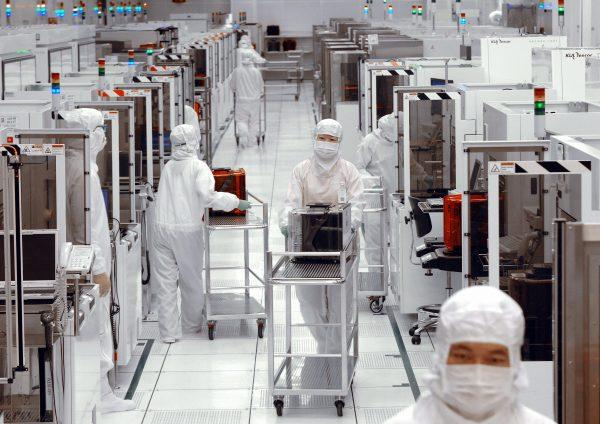The United States’ recent decision to ban the export of U.S. tech components, software, and goods to Fujian Jinhua Integrated Circuit, a Chinese semiconductor manufacturer, has sent ripples through the industry.
One of the immediate concerns is whether the ban will affect the global supply and price of DRAM circuits, a type of semiconductor chip that’s used to power virtually all computers and electronic devices.
Fujian Jinhua was months away from mass-manufacturing its own DRAM chips, Chinese media reported. The industry anticipated that such a development would immediately affect global DRAM chip prices.
But the U.S. Department of Commerce put a stop to those plans with its announcement of an export ban on Oct. 29, arguing that Fujian Jinhua “poses a significant risk of becoming involved in activities that are contrary to the national interests of the United States.” The Chinese firm—along with much of China’s semiconductor industry—relies on foreign components to manufacture its products.
On Nov. 1, U.S. authorities followed up with an announcement from the Department of Justice that Fujian Jinhua, UMC, and three Taiwan individuals had been indicted in federal court on charges of conspiring to steal trade secrets from Micron, related to the development of DRAM chips.
U.S. Attorney General Jeff Sessions unveiled the indictment at a news conference on Nov. 1, where he also announced that the department is launching a new initiative to pursue cases of Chinese economic espionage more aggressively, highlighting the importance of DRAM technology.
Park Yu-ak, an analyst at Kiwoom Securities, a South Korean financial-services provider, said the ban likely won’t have a substantial impact on the global DRAM industry and prices, according to a Nov. 1 online article published by South Korean magazine Smart PC Love.
That’s because Fujian Jinhua isn’t currently producing DRAM chips, so the ban likely will only make the designing, testing, and manufacturing phases more difficult, Park said.
Chinese semiconductor firms make up a minuscule portion of the world’s DRAM market share. South Korea has the world’s top two DRAM makers, Samsung and SK Hynix, with the former having a market share of 44.9 percent in the first quarter of this year, with the latter at 22.9 percent, according to research firm Trendfore. U.S. memory chip maker Micron, at 22.6 percent, is No. 3.

Three Taiwanese companies, Nanya, Winbond, and Powerchip, came in at fourth (2.8 percent), fifth (0.8 percent), and sixth place (0.5 percent), respectively. Other companies around the world make up the remaining 0.6 percent of market share.
DRAM prices, which peaked in the third quarter last year, have since been on the decline. But prices will likely surge next year, if the global demand for mobile phones, computers, and servers increases, according to Smart PC Love.
China’s DRAM Ambition
The export ban on Fujian Jinhua has only shed light on how far behind China’s semiconductor industry remains.
China, even as the world’s largest consumer of semiconductors, continues to lag in developing domestic semiconductor technology, when compared to traditional semiconductor powerhouses in South Korea, Japan, Taiwan, and the United States. Thus, China relies heavily on imports to meet domestic demand.
Trade organization China Semiconductor Industry Association (CSIA) estimated that domestic-made chips accounted for less than 20 percent of China’s demand in 2017. That year, China imported integrated circuits worth about $260 billion, according to CSIA data. That is more than the value of crude oil imported by China.
So China has pushed aggressively to become self-sufficient in producing domestic semiconductors—part of its industrial plan to transform the country into a tech manufacturing powerhouse, named “Made in China 2025.” Under the plan, Beijing wants domestic chips used in smartphones to make up 40 percent of the local market by 2025, according to Reuters.
Fujian Jinhua was a key part of the country’s ambitions. According to a July 2016 report by China’s state-run media Xinhua, the company was specifically listed as a key participant to building up China’s IC sector under Beijing’s 13th Five Year Plan (2016–2020).
The firm was established in February 2016 with state-backed funding—from state-run company Fujian Electronics and Information Group, and the municipal governments of Quanzhou and Jinjiang, both located in Fujian Province.
And as part of its plans, Fujian Jinhua had invested 37 billion yuan (about $5.3 billion) for the first phase of construction for a DRAM factory—which broke ground in July 2017. The company received an additional 3 billion yuan (about $431 million) from a state-backed fund, according to Xinhua.
With enough funding but still lacking semiconductor technology and experts, Fujian Jinhua turned to Taiwanese semiconductor contract manufacturer UMC to supply it with memory-related technologies, under a cooperation agreement signed in 2016. In return, Fujian Jinhua was to provide UMC with DRAM-related equipment and a service fee.
The cooperation resulted in UMC’s deputy general manager, Stephen Chen, temporarily taking over the president position at Fujian Jinhua. Notably, Chen was a former president for one of the Micron’s factories in Taiwan before joining UMC.
In December 2017, Taiwanese prosecutors charged Chen and another former Micron executive with theft of trade secrets, alleging that they tried to recruit Micron engineers to join UMC.

Since then, Fujian Jinhua and Micron have been at loggerheads. First, Micron filed a civil lawsuit in California, accusing UMC and Fujian Jinhua of stealing its trade secrets. A month later, UMC filed a countersuit, alleging patent infringement, against Micron at China’s Fuzhou City Intermediate People’s Court in Fujian Province.
In June, the Chinese court ruled in favor of UMC, banning the U.S. chipmaker from selling 26 chip products in China, according to Reuters.
The Justice Department announcement on Nov. 1 revealed that a U.S. federal grand jury had weighed in on the debacle, indicting UMC, Fujian Jinhua, Chen, and two other former Micron employees whom Chen allegedly recruited.
The indictment mirrors allegations in the Micron lawsuit, claiming that Fujian Jinhua stole DRAM technology from Micron through the cooperation agreement with UMC, which stipulated that UMC provide Fujian Jinhua with DRAM technology so the latter could mass-manufacture the DRAM chips.
The scheme worked thusly: Chen recruited employees at the Micron factory he previously headed so that they could take Micron files with them before working for UMC, according to the Justice Department press release.
The department also filed a civil lawsuit to prohibit UMC and Fujian Jinhua from exporting to the United States any products that were made using the allegedly stolen trade secrets.
The two companies face a maximum fine of $20 billion, while the individuals face up to 25 years imprisonment and a $5 million fine.
The Future for Fujian Jinhua
The ban on Fujian Jinhua is similar to a prior U.S. ban against Chinese telecoms firm, ZTE, in April.
ZTE was blocked from buying from U.S. suppliers, after the Commerce Department said the Chinese firm had failed to comply with stipulations, because of violations of U.S. sanctions placed on Iran and North Korea. The ban on ZTE, which almost put the company out of business. was eventually lifted in July after the firm agreed to pay a settlement fee of $1 billion.
ZTE is still struggling financially. According to Chinese financial website JRJ.com, ZTE suffered a loss of 7.26 billion yuan (about $1.05 billion) for the first three quarters this year. The company will likely suffer a financial loss of 6.2 billion yuan (about $893 million) for the total of 2018.
Industry experts are speculating that Fujian Jinhua might end up in similar financial straits.
Fujian Jinhua will “probably be unable to fabricate semiconductors without American-made manufacturing equipment,” Robert Maire, president of the consultancy firm Semiconductor Advisers, said in a recent interview with Japanese media Nikkei. Semiconductor firms commonly source equipment from three California-based manufacturers: Applied Materials, Lam Research, and KLA-Tencor, Nikkei reported.
Meanwhile, Chinese business news site Yicai reported Oct. 30 that U.S. suppliers IBM, Lam Research, and Applied Materials have all severed their telephone communications and email exchanges with Fujian Jinhua. Many of Fujian Jinhua’s equipment orders to U.S. companies are now put on hold, according to the report.
The ban on Fujian Jinhua has set a precedent—Chinese companies that have been accused of stealing trade secrets from the United States will likely soon face similar bans, according to an analysis by the Hong Kong Economic Times in an Oct. 30 article.





Friends Read Free